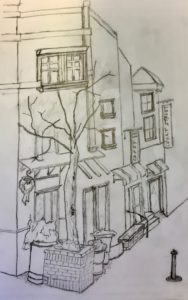 At the time of the winter solstice, the veil between heaven and earth narrows, opening us to the possibility of transformation. In some spiritual traditions, it’s called a thin place, an idea that captured my attention enough to use it as the title for my debut novel. Thin Places is the story of two people struggling with enormous loss —a young girl who’s been abandoned by her mother and a therapist who’s grieving the tragic death of her husband. Therapy is the thin place that transforms brokenness into healing.
At the time of the winter solstice, the veil between heaven and earth narrows, opening us to the possibility of transformation. In some spiritual traditions, it’s called a thin place, an idea that captured my attention enough to use it as the title for my debut novel. Thin Places is the story of two people struggling with enormous loss —a young girl who’s been abandoned by her mother and a therapist who’s grieving the tragic death of her husband. Therapy is the thin place that transforms brokenness into healing.
I’ve been witness to many thin places in my life—moments of opportunity, of joy, of a vision beyond myself. Sacred temples perched on a mountain top in Bhutan. Michelangelo’s David. Listening to Mary Oliver recite her poem, The Summer Day. The belly laugh of my children. The sweet and pungent taste of a slice of cherry pie.
The last six months, while recovering from a back injury, has surely not felt like an opportunity for transformation. In fact, I’ve experienced myself as standing outside of my life. As if I were experiencing not so much the pause of a sacred moment but the sharp-edged spidery crack of broken porcelain.
Along the way, I’ve deluded myself into believing that at some point, I would simply step back into my life. Everything from the past six months would be forgotten—and forgiven. Like those moving walkways in an airport—you can get on and off at any time. Luggage and all. No worries, because they always lead to the same gate at the end of the terminal.
In this spidery crack that is my life, I’ve had plenty of opportunity to contemplate what’s next—if what’s next is to be something different from the past.
 Lately I’ve been trying my hand at sketching. I pack up my pad and pencils and take them with me on my neighborhood walk. I look for opportunities along the way to stop and draw. A bridge. Crows pecking at the grass. A jungle gym. A park bench. Sitting in a café with my coffee, I look around until I see what draws me in. I’m learning about perspective and angles and shading and plumb lines, simple concepts for now. I try to draw every line, every angle, but I’m intrigued by the idea that some lines are necessary while others are extraneous.
Lately I’ve been trying my hand at sketching. I pack up my pad and pencils and take them with me on my neighborhood walk. I look for opportunities along the way to stop and draw. A bridge. Crows pecking at the grass. A jungle gym. A park bench. Sitting in a café with my coffee, I look around until I see what draws me in. I’m learning about perspective and angles and shading and plumb lines, simple concepts for now. I try to draw every line, every angle, but I’m intrigued by the idea that some lines are necessary while others are extraneous.
I’ve discovered that it takes focused attention and concentration to see what’s really there. It is our brain that constructs—or reconstructs—what we perceive. But it is our eyes that really see. For instance, we divine a doorway from a line that disappears into the shadows. Shading suggests the depth of a planter box. Parallel lines of a sidewalk narrow into the distance. Our brains fill in the frame and the details.
It is an act of bravery and resistance to be willing to sit and stare long enough to take in what’s actually there. To draw and erase and redraw and stare some more. To see what’s real.
In these hours of concentrated focus, I feel a sense of contentment. My coffee is cold long before I’m ready to pack up my pencils. I’ve come to see that there’s no crack in my life. Unlike the airport walkway, we can’t get on and off when things get tough.
The best we can do is pray and rage and weep. And then gather up our senses and pay homage to what’s real. Because life continues, and along with the grief and loss and pain, there will also be moments of unexpected joy.
I invite you to read related posts Play it as it Lies and On Lost Sunglasses and the Meaning of Life. And my novel, Thin Places.
This is so beautiful and true Elie – What a perfect thing to read this morning! Happy New Year my friend.
Thank you Stacy! And Happy New Year to you! I can think of many of our friends who could relate to our shifting bodies and lives.
Yes, Elie, it’s all true. In similar circumstance, my mantra is: “Love It For What It Is.” “Love” ardently, fully, passionately, and “Is,” not was, not might have been, not will be.
Marvin, I love your comment. How true–and how challenging to embrace!
Hi Elie,
I love your descriptions of life and things. It’s like somebody can say cherry pie but you bring it to the point of feeling it in my mouth to almost taste; Thank you.
You have an ability to describe life in ways that bring it into perspective and make me a part of it. It’s ike reading about cherry pie and then someone like you puts it in my mouth and I experience it another way. Thank you and Happy New Year. I’m really impressed by your trying drawing and the picture is great.
Take care
Thanks Lois! Love that piece of cherry pie :-).
Elie, I got tears in my eyes after reading your latest writing and the transformation that is occurring in your life as a result of a physical challenge. It is an example and a reminder that we can all make changes
and find new and beautiful parts of ourselves. I like your drawing…… and the observations . I shall
think about ways that I can transform in the New Year. HAPPY NEW YEAR…i see a book of your drawings in the future.
Thanks Judy! Glad to hear this post is helping you to think about transforming in the New Year!
Beautiful, Elie, both your words and your drawing.
Good thoughts here. Very nice drawing, somehow it strikes me as a French street scene.
I recall from a drawing class I had long ago: the challenge of putting the 3 dimensional into to the 2 dimensional. I also recall how much it required in changing “my seeing”—that there is really so much to SEE when drawing and making this translation. I like your comment about what to leave out in this. Somewhat true of photography too. Happy New Year, you visionary.
Thanks Paul! I’m intrigued especially by portrait artists who can capture a face with only a few strokes. Happy New Year to you too!